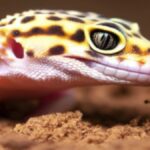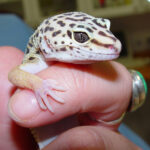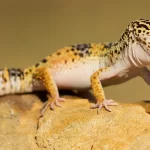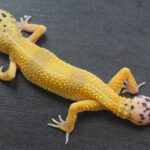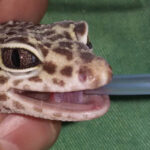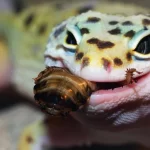Quarantine is applied for new arrivals or in case of exposure to diseases. Owners should familiarise themselves with the Leopard gecko quarantine process.
Leopard gecko quarantine introduction
Quarantine is defined as a state or place of isolation or keeping separate from others. Its function is to prevent diseases from being transmitted from one Leopard gecko to another, or to humans.
The health status of newly acquired Leopard geckos is usually unknown. It is often difficult to diagnose certain diseases before clinical signs are present. Some diseases are subclinical, meaning that there might be no visible or measurable signs of ill health. This means that chances are that even a healthy-looking Leopard gecko might have a contagious disease at the time of purchase. To prevent exposing other reptiles, and even humans, to potential diseases, newly acquired Leopard geckos can be quarantined.
Quarantine principles can also apply for the isolation of Leopard geckos that are known to be sick or injured.
When a Leopard gecko or an enclosure mate has been diagnosed with a contagious disease, chances are that that disease will spread. By separating healthy and sick Leopard geckos from each other, disease transmission is reduced. If done early enough, transmission can even be prevented. Even if the disease has been transmitted already, its further spread can be prevented by quarantine. While in isolation, treatment, management and monitoring protocols can be applied.
Injured Leopard geckos are isolated to allow for rest during the recovery period.
Also see
Tail injuries in Leopard geckos
Leopard gecko bite wounds
Quarantine can also refer to the period the isolation is enforced. Because some diseases in Leopard geckos might take weeks to months to show clinical signs, the quarantine period is often enforced for up to six months.
Common diseases and conditions that can be prevented by enforcing quarantine include:
- Adenovirus infections
- Cryptosporidiosis
- Mite infestations
- Helminths
Leopard Geckos 101 is a free, informative website helping to improve the quality of pet Leopard geckos. If you found value in any of its content, please consider making a donation. Also see the other ways to support Leopard geckos 101.
Infectious vs. contagious diseases
Many Leopard gecko diseases are infectious and/or contagious in nature. Infectious diseases are those that infect the body. They are caused by micro-organisms such as bacteria, viruses and protozoans. Not all infectious diseases are known to spread or to be transferred between individuals, but if they can, they are called contagious. The correct quarantine protocols will prevent the spread of contagious diseases.
In Leopard geckos, one of the more important infectious diseases is cryptosporidiosis (Cryptosporidium spp.). This disease is also highly contagious and can spread between many reptile species. Cryptosporidium can be transferred to humans and between Leopard geckos through infected faeces.
Adenovirus infection in Leopard geckos is rare but is also highly contagious. It is believed to spread through infected faeces and respiratory droplets and readily transferred between Leopard geckos.
Salmonellosis is an infectious disease in humans that can be transmitted from reptiles. Although strictly not infectious, helminths (worms) and mites (Ophionyssus & Hirstiella spp.) can also spread from one Leopard gecko to another.
Also see
Cryptosporidiosis in Leopard geckos
Mite infestations in Leopard geckos
While some diseases are ‘visible’, others might be ‘silent’. Clinical signs are signs that indicate disease. Common clinical signs include weight loss, anorexia (a refusal to eat) and regurgitation. There are many others. Most diseases will be associated with clinical signs, which can be used by, for example, a veterinarian, to make a diagnosis.
Some diseases will show no clinical signs — called subclinical diseases. Some subclinical diseases are still contagious.
More commonly, some diseases will take time to show clinical signs. Although many of these diseases can already be transferred to other individuals, the individual shows no signs of ill health, yet.
Some diseases are transferred from asymptomatic carriers. Salmonella, for example, can be transferred from reptiles to humans, although reptiles will not get sick (or show any clinical signs) from it. Adenovirus and Cryptosporidium infections can also be spread from asymptomatic and subclinical carriers.
Also see
What to look for in a healthy baby Lepard gecko
The quarantine period
Now that it has been established that all newly acquired and disease-exposed Leopard geckos should be quarantined, it is time to look at how long the quarantine period should be.
As mentioned earlier, some conditions and diseases will take time to become apparent and show clinical signs. This is often called the incubation period. Each disease/condition will have its own incubation period. The recommended quarantine period for a Leopard gecko is determined by the diseases that would take the longest to show signs (i.e. has the longest incubation period). When an animal is free of disease after the quarantine period (i.e. didn’t show any signs of disease during the quarantine period), it can be released from isolation.
The quarantine period is also often used as the period the animal needs to be disease-free (e.g. mite-free). When a Leopard gecko has been diagnosed with a disease or condition, it needs to be quarantined/isolated until the disease has been treated and/or it cannot be transmitted anymore. In these cases, the quarantine period will also refer to (or extended with) the minimum period where no more signs were visible.
Although some established breeders will quarantine newly acquired Leopard geckos for up to a year, most literature suggests between one to six months. Three months seems to be recommended frequently and will allow the identification of clinical signs for Adenovirus infections.
If, for example, a mite infestation is the only concern then a short 6 week quarantine period will be enough to be able to identify them. This is also the time a Leopard gecko needs to be mite-free after treatment before it should be released from isolation.
The author typically recommends a quarantine period for Leopard geckos and other reptiles of at least 6 months.
When certain diseases were diagnosed, it will be advisable that quarantine (or isolation) is applied life long. Some of these diseases in Leopard geckos include Cryptosporidium and Adenovirus infections.
In the case of injuries and tail loss, the affected Leopard gecko should be isolated as long as it takes for the injury to heal. In the case of autotomy (“tail drop”) this period can be between five to eight weeks(32).
The quarantine enclosure
Although the most important quarantine principles are isolation and its period, the quarantine enclosure should also be considered.
Each Leopard gecko should be isolated separately in its own ‘quarantine enclosure’. This enclosure should contain all the basic housing requirements for Leopard geckos, but preference should be given to hygiene. Enclosure furniture, food and water bowls should not be shared between Leopard geckos before it has been properly disinfected or sterilised. Items should not be moved from the room where isolation takes place.
Example of a quarantine/isolation container for Leopard geckos. Plastic containers and simple substrates are easy to clean and inspect. Image Korean Gardener (CC BY YouTube)
The quarantine enclosure should have easy access and be easy to clean and disinfect efficiently and regularly. Glass and plastic containers and furniture are often the best to use. To be able to identify visible conditions such as ticks and mites and to visualise faeces better, paper towel, non-printed paper, newspaper or brown butcher paper are the substrates of choice.
Also see
Suitable substrates for Leopard geckos
Good hygiene practices for Leopard geckos
Leopard gecko housing guidelines
Quarantine inspections
Quarantine is not only about disease prevention but also about monitoring. Leopard geckos should be inspected before, during and after the quarantine period. Veterinary examinations should be performed in the case where abnormal signs are observed.
Visual inspections can be done by keepers, but an experienced reptile-friendly veterinarian will be able to assist with more advanced ways to diagnose difficult-to-see diseases. Treatment of Leopard gecko diseases should be done under the guidance of a veterinarian.
During the quarantine period, handling should be kept to a minimum. Leopard geckos should be handled with disposable medical latex gloves to prevent the transmission of potential zoonotic diseases (diseases that can be transmitted from animals to humans).
As a summary, these are good hygiene principles for Leopard gecko owners:
- Do not touch your face while, or directly after, handling a Leopard gecko, the enclosure furniture, the inside of their enclosure, feeder insects or their substrate.
- Protect any open sores or wounds you might have on your hands before touching or handling a Leopard gecko.
- Wash and disinfect your hands (or in-contact skin) before and after handling a Leopard gecko.
- Wash and disinfect your hands (or in-contact skin) after handling enclosure furniture, the inside of the enclosure, the substrate and/or feeder insects.
- Do not kiss a Leopard gecko or bring it close to your face.
- Do not eat while in the proximity of Leopard geckos or feeder insects.
- Use safe, but proven disinfectants to wash, wipe or spray your hands.
- Use disposable medical latex gloves if possible.
For more information, also see our Leopard gecko owner hygiene article.

Hand washing
- Wet your hands with clean running water and apply soap. Use warm water if it is available.
- Rub hands together to make a lather and scrub all surfaces, including under the fingernails.
- Continue rubbing hands for 20 seconds.
- Rinse hands well under running water.
- Dry your hands using a disposable paper towel or a hand dryer.
It is also recommended to wash your hands before and after using protective gloves.
Note: These measures should be routine but are especially important while working with quarantined Leopard geckos.
Diseases that are known to be able to transmit from Leopard geckos to humans include:
- Cryptosporidium spp.
- Salmonella
- Mites
Leopard geckos should be inspected for overall health, appetite, the appearance of droppings and external parasites (e.g. ticks and mites). Routine stool inspections will monitor the presence of internal parasites such as cryptosporidiosis, roundworms, pinworms, and other protozoal infections.
The diagnosis of cryptosporidium in Leopard geckos has proved to be difficult during quarantine periods. Due to their intermitted shedding stool testing should be done on 5 to 7 consecutive stool samples(20). Obtaining weekly weights are also recommended.
Before a Leopard gecko is to be released from quarantine it should be visibly healthy, in good condition, eating well, defaecating and shed ists skin normally. The weight of growing Leopard geckos should increase steadily or at least stay the same for healthy-looking adults. Stool samples should be free from any parasites.
Also see
Good hygiene practices for Leopard geckos
General Leopard gecko care
What to look for in a healthy baby Leopard gecko
Leopard gecko soaking — warning signs
Leopard gecko eating behaviour
Conclusion
This article points out the importance of quarantining new Leopard geckos before they are introduced to other reptiles. Most transmissible diseases can be prevented by having a quarantine period between 3 and 6 months. Leopard geckos that were healthy during, or after, this period can be assumed safe from most preventible diseases and conditions. Sick and injured Leopard geckos can also be isolated during their recovery period.


